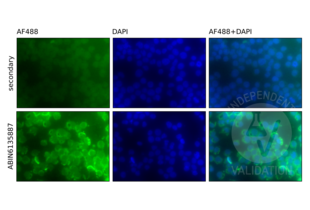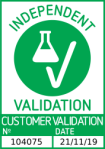NF-kB p65 抗体
Quick Overview for NF-kB p65 抗体 (ABIN6135887)
抗原
See all NF-kB p65 (NFkBP65) 抗体适用
宿主
克隆类型
标记
应用范围
-
-
交叉反应
- 人, 小鼠, 大鼠
-
产品特性
- Monoclonal Antibodies
-
免疫原
- Recombinant protein of human NF-kB p65
-
亚型
- IgG
-
-
-
-
应用备注
- WB,1:500 - 1:2000,IHC,1:50 - 1:200,IF,1:50 - 1:100,IP,1:20 - 1:50
-
说明
-
HIGH QUALITY
-
限制
- 仅限研究用
-
-
- by
- Klinik für Anästhesiologie, Intensivmedizin und Schmerztherapie des Universitätsklinikums Knappschaftskrankenhaus Bochum
- No.
- #104075
- 日期
- 2019.11.21
- 抗原
- NfkBP65
- Lot Number
- 9410609001
- Method validated
- Immunofluorescence
- Positive Control
U-937 human monocytic cell line
- Negative Control
No primary antibody control
- Notes
Passed. ABIN6135887 specifically stains RelA/p65 in U-937 human monocytic cells with antigen retrieval using 1% SDS.
- Primary Antibody
- ABIN6135887
- Secondary Antibody
- AF488-conjugated AffiniPure alpaca anti-mouse IgG antibody (Jackson Immuno Research, 615-545-214)
- Full Protocol
- Grow U-937 cells in RPMI 1640 Medium (Gibco, 21875034) supplemented with 10 % FCS (Gibco, A3840001) and Pen/Strep (Gibco, 15140122), at 37°C and 5% CO2 in 300µL in 24-well plates (Sarstedt AG&Co. KG).
- Use cytospin to spin cells onto slide.
- Fix cells on coverslide in 4% paraformaldehyde (Carl Roth GmbH, 0335.1) for 30min at RT.
- Wash cells 3x for 5min with PBS (Sigma-Aldrich, 8537).
- Permeabilize cells in 100µL PBS containing 0.1 % Triton X-100 (Sigma-Aldrich, T8787) for 5min at RT.
- Wash cells 3x for 5min with PBS.
- Permeablilize cells in 100 µL PBS containing 1 % SDS (0183, Carl Roth GmbH) for 5 min at RT.
- Wash cells 3x for 5 min with PBS.
- Block non-specific binding with 1x Duolink Blocking solution (Sigma-Aldrich, DUO82007) for 30min at RT.
- Incubate cells with primary mouse anti-human RelA/p65 antibody (antibodies-online, ABIN6135887, lot 9410609001) diluted 1:100 in 1x Duolink Antibody diluent (Sigma-Aldrich, DUO82008) ON at 4°C.
- Wash cells 3x for 5min with PBS.
- Incubate cells with secondary AF488-conjugated AffiniPure alpaca anti-mouse IgG antibody (Jackson Immuno Research, 615-545-214) diluted 1:400 in 1x Duolink Antibody diluent for 1h at RT in the dark.
- Wash cells 2x for 5min with PBS.
- Mount coverslips on glass slides in 50µL ProLong Gold antifade mountant with DAPI (Invitrogen, P36931).
- Image acquisition with an Olympus widefield microscope.
- Experimental Notes
Strong green staining dependent on the presence of primary antibody indicates that the antibody works. Negative control lacking the primary antibody shows only background fluorescence. Staining was obtained using antigen retrieval (1% SDS). Without this the antibody did not yield detectable signal.
生效 #104075 (Immunofluorescence)![成功验证 '独立验证'标志]()
![成功验证 '独立验证'标志]() Validation ImagesFull Methods
Validation ImagesFull Methods -
-
状态
- Liquid
-
缓冲液
- PBS with 0.02 % sodium azide,50 % glycerol, pH 7.3.
-
储存液
- Sodium azide
-
注意事项
- This product contains Sodium azide: a POISONOUS AND HAZARDOUS SUBSTANCE which should be handled by trained staff only.
-
储存条件
- -20 °C
-
储存方法
- Store at -20°C. Avoid freeze / thaw cycles.
-
-
-
: "Porcine Deltacoronavirus Accessory Protein NS6 Antagonizes Interferon Beta Production by Interfering with the Binding of RIG-I/MDA5 to Double-Stranded RNA." in: Journal of virology, Vol. 92, Issue 15, (2018) (PubMed).
-
: "Porcine Deltacoronavirus Accessory Protein NS6 Antagonizes Interferon Beta Production by Interfering with the Binding of RIG-I/MDA5 to Double-Stranded RNA." in: Journal of virology, Vol. 92, Issue 15, (2018) (PubMed).
-
- NF-kB p65 (NFkBP65) (Nuclear Factor-kB p65 (NFkBP65))
-
别名
- RELA
-
背景
- NF-kappa-B is a ubiquitous transcription factor involved in several biological processes. It is held in the cytoplasm in an inactive state by specific inhibitors. Upon degradation of the inhibitor, NF-kappa-B moves to the nucleus and activates transcription of specific genes. NF-kappa-B is composed of NFKB1 or NFKB2 bound to either REL, RELA, or RELB. The most abundant form of NF-kappa-B is NFKB1 complexed with the product of this gene, RELA. Four transcript variants encoding different isoforms have been found for this gene.,NFKB3,p65,NF-kB p65,RELA,CMCU,Epigenetics & Nuclear Signaling,Transcription Factors,Cancer,Signal Transduction,MAPK-P38 Signaling Pathway,Cell Biology & Developmental Biology,Apoptosis,Inhibition of Apoptosis,Death Receptor Signaling Pathway,Endocrine & Metabolism,Endocrine and metabolic diseases,Obesity,Immunology & Inflammation,B Cell Receptor Signaling Pathway,T Cell Receptor Signaling Pathway,IL-6 Receptor Signaling Pathway,NF-kB Signaling Pathway,Toll-like Receptor Signaling Pathway,Neuroscience,Neurodegenerative Diseases,Amyloid Plaque and Neurofibrillary Tangle Formation in Alzheimer's Disease,Cardiovascular,RELA
-
分子量
- 58 kDa/59 kDa/60 kDa
-
基因ID
- 5970
-
UniProt
- Q04206
-
途径
- NF-kappaB Signaling, RTK signaling, TCR Signaling, TLR signaling, Fc-epsilon Receptor Signaling Pathway, Neurotrophin Signaling Pathway, Activation of Innate immune Response, Cellular Response to Molecule of Bacterial Origin, Hepatitis C, Toll-Like Receptors Cascades, S100 Proteins
抗原
-


 (1 reference)
(1 reference) (1 validation)
(1 validation)



